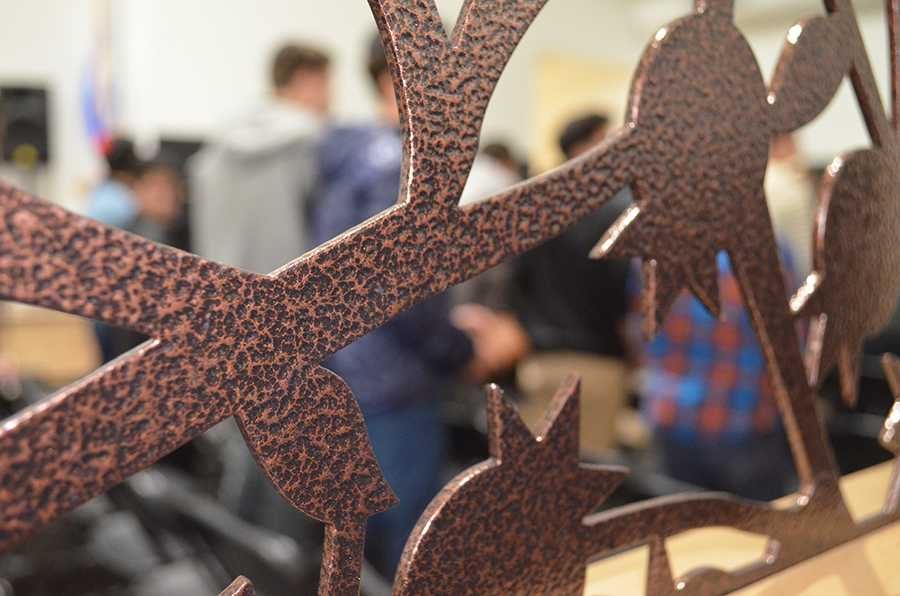Taller, kosher mechitzot bring Israeli artistry to school
SYMBOLIC: Metal panels in a pomegranate pattern bring the mechitzot to the proper halachic height.
February 16, 2016
New mechitzot for the building were finally completed Dec. 15, with laser-cut metal panels in a pomegranate design across the top to make them both halachically permissible and artistic.
Designed with both halacha and the state of Israel in mind, the panels were purchased from Kibbutz Lavi in the Lower Galilee and are in all davening spaces, including the Beit Midrash, Beit Knesset and the gym.
“It was the prettiest of the decorative options open to us,” said Executive Director Robyn Lewis. She also said pomegranates are symbolic in Judaism because the number of seeds inside of a pomegranate is roughly 613, which corresponds to the number of mitzvot in the Torah.
Mrs. Lewis said that, while Kibbutz Lavi is known for making beautiful things, the school had another reason for choosing them to build it.
“We are always trying to support Israel and Israeli businesses,” Mrs. Lewis said.
While she declined to give the cost of the mechitzot, she said the kibbutz was “a very good partner in helping us to save money.”
At the JCC last year, Shalhevet used a wooden frame with black cloth stretched across it as the mechitzot. This is the first year using specially designed mechitzot.
The concept of a mechitza was first seen in the Beit Hamikdash, the Holy Temple in Jerusalem, according to most historians. There, the mechitza preserved modesty by preventing men from seeing women while they prayed.
Today’s rabbis disagree about what the minimum height of a mechitza should be, because it was not included in the Shulchan Aruch, which was first published in the year 1565. According to Reb Weissman, there was no reason for a law at that time since women either didn’t go to shul or sat in a balcony out of men’s view.
When mechitzot became part of synagogue architecture in the U.S., Rabbi Moshe Feinstein and Rav Joseph B. Soloveitchik — two of the leading American halachic authorities of the 20th century – each gave an opinion on the matter. Rav Moshe said at least 54 inches high, while Rav Soloveitchik said 50 inches.
Before the new panels were installed, Shalhevet’s mechitzot only measured 49 inches tall. That came as a surprise to Reb Weissman.
“Really?” he asked, when told by The Boiling Point. “It is a big deal halachically – I thought we knew exactly how high the mechitza was. We follow Rav Moshe’s and Rav Soloveitchick’s shita [decision].”
But with the pomegranate panels now in place, they measure 61 inches – taller than the minimum according to both opinions.
Even though most students are taller than the mechitzot and could look over them or through the grated metal pomegranates, Reb Weissman said that is not a problem. Through email, he explained that their purpose isn’t to prevent people from looking at each other.
“From my understanding, the main reason we have mechitzot is not to have kallut rosh, or frivolity,” said Reb Weissman. “Tefilah is an incredibly serious and meaningful opportunity. Making sure we focus and have the proper mindset is key.”
Judaic Studies teacher Rabbi David Stein said that there are two understandings of the purpose of mechitza, but only one is widely recognized.
“Either the purpose is about stopping people from seeing each other, which it’s not, or the purpose of mechitza is just about creating the separation and creating a sacred space,” Rabbi Stein said in an interview.
Rabbi Stein said another reason for mechitzot is tradition.
“Our shuls, our beit knessets are modeled and designed to be mikdash mihadrin, meaning batei mikdash,” or houses of worship, said Rabbi Stein. “Particularly, we try to adopt some of the architecture that was in the Beit Hamikdash,” the holy temple in Jerusalem.
On school trips mechitzot are not used, but Reb Weissman said that it is alright because they are unnecessary.
“The mechitza is only for the function of a shul,” he explained. “When you have a minyan that is ad-hoc, you don’t need a mechitza, you need to just separate the men and the women.”













